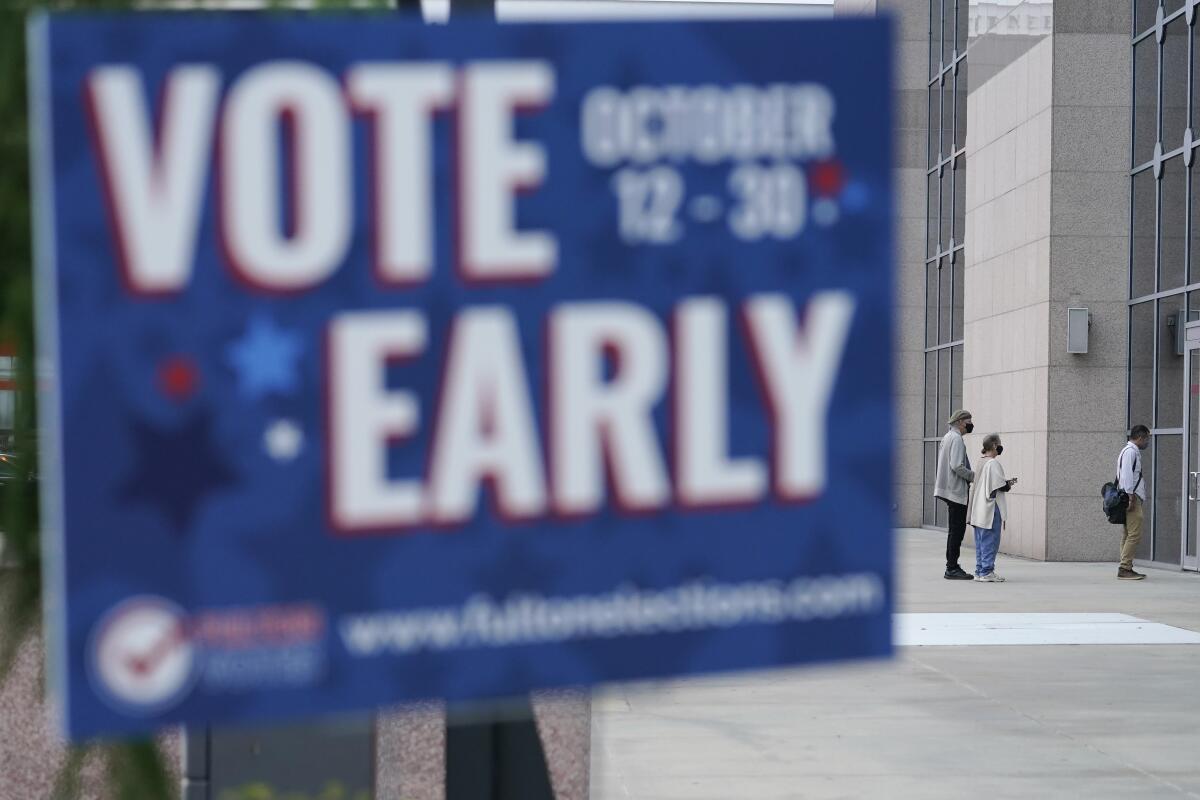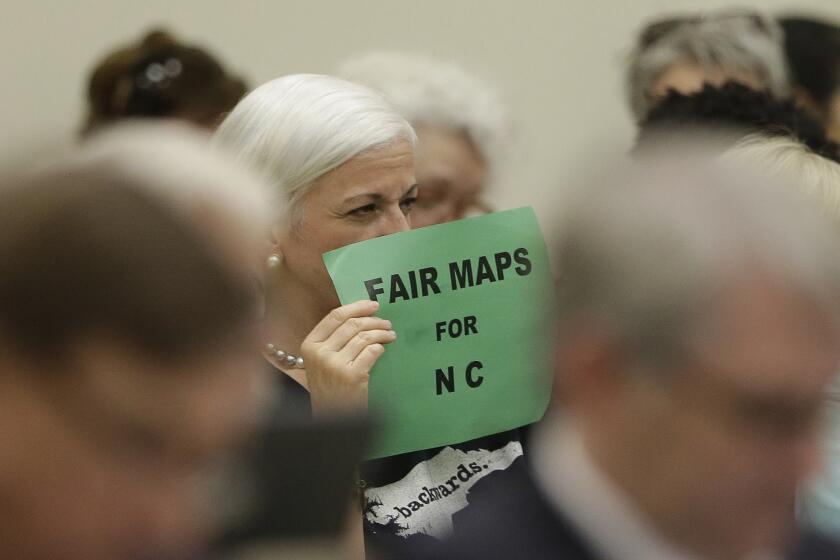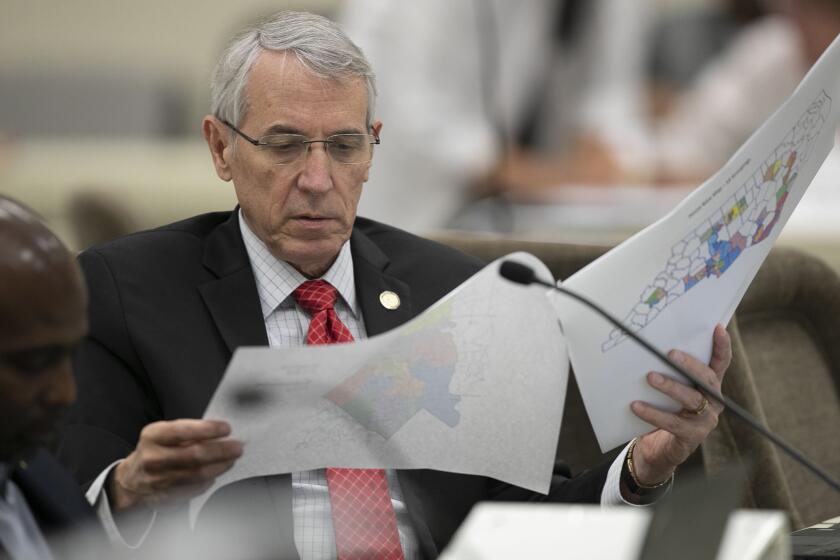South emerges as flashpoint in fight over redistricting — and for control of Congress

- Share via
The partisan showdown over redistricting has hardly begun, but already both sides agree on one thing: It largely comes down to the South.
The states from North Carolina to Texas are set to be premier battlegrounds for the once-a-decade fight over redrawing political boundaries. That’s thanks to a population boom, mostly one-party rule and a new legal landscape that removes federal oversight and delays civil rights challenges.
It’s a collision of factors likely to tilt the scales in the GOP’s favor with dramatic impact: Experts note the new maps in the South alone could knock Democrats out of power in the U.S. House next year — and perhaps well beyond.
“The South is really going to stand out,” said Ryan Weichelt, a geography professor at the University of Wisconsin-Eau Claire who tracks redistricting.
Of the 10 new congressional seats expected this year, six are likely to be in Southern states, with a new one expected in North Carolina, two in Florida and three in Texas.
Republicans control the Legislatures in those states, leaving them with near total say over what those new districts will look like — a sharp contrast to other parts of the country where state governments are divided or where nonpartisan commissions are tasked with redrawing congressional and state legislative lines.
The deceased Republican strategist was concerned that Democrats were developing better data that could give them an advantage in the next round of redistricting
Finally, this will be the first time in more than 50 years that the federal Justice Department will not automatically review new legislative maps in nine mostly Southern states to ensure they do not discriminate.
“It is a very different landscape from the one that it’s been for 50-plus years,” said Deuel Ross, senior counsel at the NAACP Legal Defense Fund.
Republicans are under added pressure to bolster their political standing in the region as its population has grown, largely from an influx of Democratic-leaning newcomers. That’s weakened the GOP’s grip, highlighted most dramatically in Georgia, where Democrats just won a presidential race and two Senate races.
The GOP is already eyeing targets. In Georgia, they can choose whether to target Democratic Reps. Lucy McBath or Carolyn Boudreaux or both by adding more conservative voters from far north of Atlanta to the two lawmakers’ districts.
Editorial: California’s independent redistricting commission has no Latinos? That’s an embarrassment
Not one Latino was selected in a random drawing for the first eight members of the new state redistricting commission.
In Florida, they could try to swamp Democratic Rep. Stephanie Murphy’s district with new GOP voters as they carve out a new seat in the Orlando area, one of the two the state is expected to add.
And in Texas, which is expected to gain a whopping three congressional seats, the most of any state, the GOP may try to carve out more seats in the center of their state’s boom — Democratic-leaning Houston — that could still elect Republicans.
Currently, a gain of five seats would hand control of the House to the GOP. That number may rise or fall before November depending on the outcome of special elections for several vacant seats.
To be sure, there will be limits — both legal and practical — on how much power Republicans can win with a new map. While they control the process, the demographic trends in Southern states are working against them. Many of the new residents are college-educated, racially diverse and young — all groups that Republicans have struggled to win over.
The reins of political power will be at stake in the 2020 U.S. elections — not just for the presidency, but for thousands of state House and Senate seats.
That means the party can draw only so many “safe” districts. And because these states are seeing explosive growth, efforts to perfectly divvy up major cities like Houston and Atlanta may collapse over time as tens of thousands of new residents continue to move in.
“You’ve got all these countervailing things,” said Steve Schale, a Florida-based Democratic strategist, including “Democrats doing better in suburban areas, states getting more diverse, coupled with Republicans being in control of all the levers of government.”
Control in the South has a history of leading to a rigging of the democratic process — from imposing voting rules to redrawing district maps — to disenfranchise Black voters. In Georgia, the state’s GOP-controlled Legislature is responding to Democrats’ recent surge and former President Trump’s false claim of voter fraud with a raft of proposals that would make it harder to vote — including one to end Sunday early voting, popular among Black churchgoers.
Such restrictions wouldn’t have been possible eight years ago, when the Justice Department was required to approve any changes ahead of time in states with a history of voting rights violations. But in 2013, the conservative majority on the Supreme Court struck down federal requirements that Georgia and eight other states “preclear” voting and redistricting changes. It ruled that the federal formula based on the states’ previous violations was outdated.
Get our L.A. Times Politics newsletter
The latest news, analysis and insights from our politics team.
You may occasionally receive promotional content from the Los Angeles Times.
Several states, including Texas and the Carolinas, quickly responded with new voter-identification laws. Some civil rights advocates fear the party will take advantage of the lack of oversight in redistricting as well.
“If they’re using what was obviously a lie about voter fraud in 2020 to pass new restrictions on voting in Georgia and Texas, then I think the same will apply when the census data comes out” to kickstart the redistricting process, Ross said.
Redistricting on the basis of race remains illegal under the Voting Rights Act. But proving a violation can take years in court, allowing multiple elections to go forward with maps that may later be found illegal. For example, in North Carolina, where the Republican-dominated Legislature alone has redistricting power, without input from the state’s Democratic governor, the Legislature drew maps in 2010 that were eventually found to be racially gerrymandered. But those maps remained in place for two House elections before being redrawn to cost the GOP two seats.
“It means a state can engage in midnight gerrymandering and essentially evade court review, run elections with those gerrymandered maps and get away with it until the next election,” said Kathay Feng, Common Cause’s redistricting director.
The 2020 census has been battered by criticism that it was politicized by the administration of former President Donald Trump
Jason Torchinsky, general counsel of the National Republican Redistricting Trust, said there are significant limits on what Republican-controlled Legislatures could accomplish even if they went down the road of racial gerrymandering — which, he noted, could still result in damaging lawsuits and injunctions against maps from federal judges.
“This notion that, somehow, the lack of preclearance is going to leave minorities unprotected is false,” Torchinsky said.
Some Republicans note that the party should be careful not to let its power over the rules and the boundaries replace persuasion. It must still try to win over new arrivals in the South with ideas.
“We need to remind these new residents that they’re moving to these states, ideally, based on policies Republicans have put in place,” said Hooff Cooksey, a Virginia-based GOP strategist.
Virginia looms as a warning to the GOP — a once solidly Republican state that became a solidly Democratic one as the growing, educated population in the Washington suburbs turned against the GOP. A federal court redrew the state’s maps in 2016 because it found that the Legislature — split between both parties — and a Republican governor had improperly used racial criteria in redistricting.
Democrats won the statehouse in 2019, and Virginia now uses a nonpartisan commission to draw its legislative maps.
More to Read
Sign up for Essential California
The most important California stories and recommendations in your inbox every morning.
You may occasionally receive promotional content from the Los Angeles Times.














